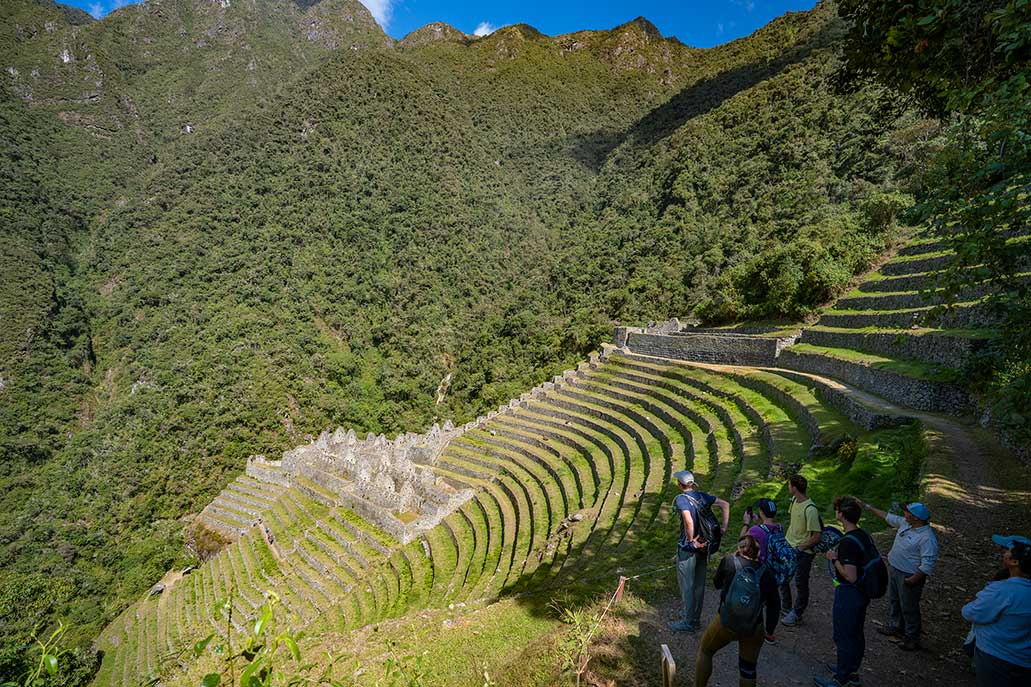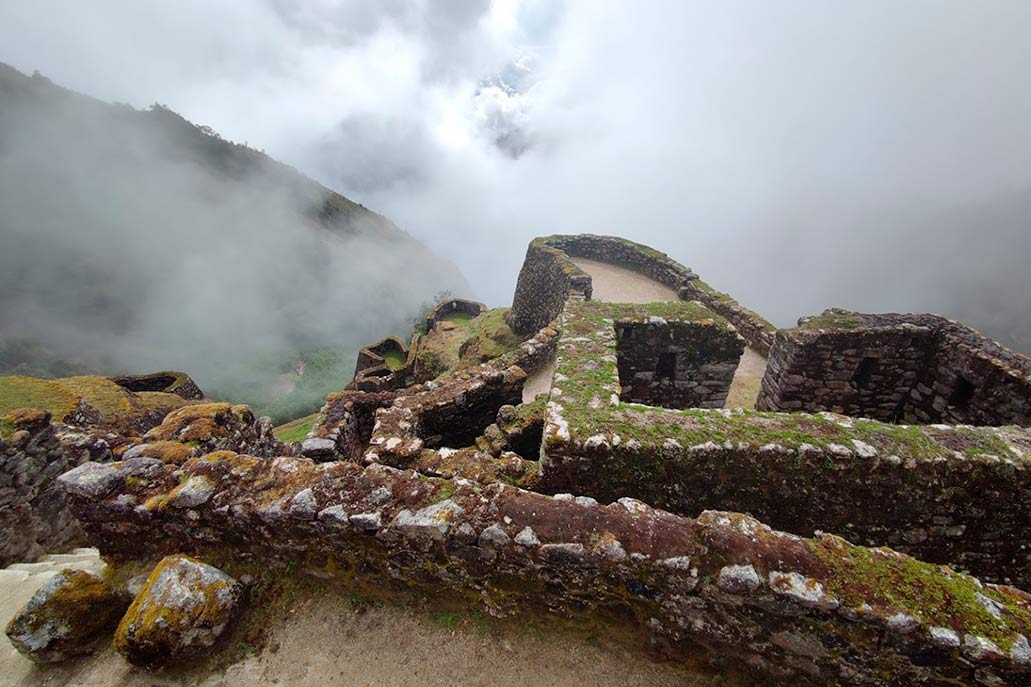The 4-day Inca Trail and the archaeological sites you will see
Machu Picchu is the favorite destination of our beautiful Cusco. In Machu Picchu, you can see the great urban planning capacity of the ancient inhabitants of the Peruvian Andes. For this and other factors, it is recognized as one of the wonders of the modern world. Nowadays, it is possible to visit Machu Picchu along the same lines or routes left by the inhabitants of Tawantinsuyo. This 4-day hiking route is known as the Inca Trail. During the walk, it is possible to find different types of landscapes, cross the Andes, and find archaeological sites that remain standing to this day and help to understand more about the culture and lifestyle of the Incas.
Content
The 4-Day Inca Trail to Machu Picchu
The 4-Day Inca Trail is one of the most popular and beautiful hiking tours that can be done in Peru. Thanks to the Andes Mountains, Peru offers different landscapes crowned by, almost always, a blue sky. That is why doing the route to Machu Picchu for 4 days offers a surprising experience. As an example, the change in geography is experienced when crossing the icy mountains and entering the warmth of the high jungle, surrounded by abundant vegetation.
For whom is this hiking route recommended? The 4-day Inca Trail is a demanding route but with great surprises. It is recommended for people who like history and archaeology. Likewise, it can be done by those who see it as a challenge, those who want to only have contact with their family or friends and, as a second option, have a unique contact with nature. Enjoying clean, pollution-free air is also another of the main reasons why anyone could decide to do this 4-day adventure.
Likewise, it is not necessary to have much physical preparation to do this route. It will only be enough to do prior acclimatization in Cusco, especially if upon arrival you already feel the problems or symptoms of altitude sickness. To avoid that, it is recommended that you arrive in Cusco one or two days before starting the tour. After that, it is not necessary to have adequate physical condition, but it is necessary to at least exercise regularly. Adequate physical condition will allow you to reach the place without any problem and enjoy the entire adventure. Whereas, with poor physical condition, walking can be punishing.
In the case of sedentary people who, for work reasons, do not have an active life or have little time to dedicate themselves to exercising, it will be recommended that they take some short walks combining physical activities with short running routes. All this from the moment you book, remember that you will have to book well in advance. Only in this way will you be able to make the 39-kilometer walk in total. In case you are discouraged by the hike, you can opt for the 2-day Inca Trail. In this activity, you travel 11 kilometers on average. Both cases are similar, however, the change in geography is not as evident as in the case of the 4-day Inca Trail, and fewer archaeological sites are visited.
One of the main attractions of this entire tour is that it has a lot of history and culture. History because you cross the paths drawn by the urban planners and architects of Tawantinsuyo and also because you can see different constructions, which we will talk about later. As for history, it is because we can know and know, according to the archaeological remains, the ways of life and the expansion process and planning that the Inca rulers had. The archaeological sites visited during this walk surprised me with their classic Inca constructions that defy gravity and cliffs.
Another important aspect of this tour is that we will be able to see the Inca Trails. The Inca Trails are a clear example of the mastery of geography in combination with engineering. In the sense that they could adapt routes in humid geographies, cliffs, and even inside large stones. Traveling all these paths is a spectacle apart.
Corihuayrachina
It is one of the first buildings that can be found when starting the Inca walk. Before starting the walk, you will probably visit Ollantaytambo. However, Corihuayrachina is located right at the beginning of the walk, even a few meters from the control area. However, it is not very popular and few people have managed to visit it.
This archaeological site is located at kilometer 88, near the banks of the Urubamba or Vilcanota River, so those who arrive at this place start the Inca Trail first cross a bridge. Like other constructions, it probably served the function of a dairy farm. It was surely a control point and was made up of several buildings in which, to this day, traces of temples and the remains of some colcas or warehouses stand out.
Its construction is likely due to Pachacutec’s first incursions into the Cusco jungle. Like all Inca dairy farms, you can find the presence of terraces and water channels. This shows us that the planning of their dairy farms or resting places was perfectly planned so that the entire place and buildings could enjoy the water.
Llactapata
A few kilometers from Corihuayrachina, there is also the Llactapata dairy farm. This construction is bordered by two rivers, which are the Urubamba or Vilcanota and the Cusicancha. So it was surely one of the buildings dedicated exclusively to agriculture since it had a large amount of water.
When traveling by train to Machu Picchu Pueblo, one can appreciate part of its construction.From this perspective, you can see a large part of its terraces and retaining walls that surely served as protection in case the river that surrounds it overflows. As is usual in Inca constructions, the beautiful landscapes and views of the valley cannot be missed.
This is a must-see destination for those who do the Inca Trail. It is only 3 hours from the start of the walk. The tour does not take much time, but it will not fail to surprise you as you appreciate the perfect symmetry of the temples and the resistance they still have, despite receiving little maintenance. Since you visit this place, you begin to better understand the very important function that the entire road network has.
It is important to know the variation in climate along the Inca Trail. This is because not only does it follow one type of geography, on the contrary, it crosses the Cusco Andes to enter the high jungle of Cusco. Where Wiñayhuayna and Machu Picchu are already located. When we reach the high jungle, we will find a warmer and more humid climate with the probability that it will rain momentarily. When you start the walk you will probably feel a little cold if it is cloudy. Normally the first two days you feel cold because the route is done in high or high altitude areas.
Runkurakay
Like all the destinations we are looking at here, Runkurakay is a destination that can only be visited by doing the Inca Trail hiking route to Machu Picchu. It is located 8 kilometers from the Inca citadel. Due to its location, it was likely a colca or a resting place for the Tawantinsuyo emissaries, the Chaskis.
However, more things can be inferred from the shape of its structure. For example, having a circular shape it can be assumed that the construction could represent a temple or a construction dedicated to religion. However, there is also the hypothesis that it may have played the role of a large colca. This is so that any traveler can replenish their food or similar items.
The construction is on platforms that give it the shape of a pyramid. That’s probably the main reason for the name it has. If we translate from Quechua, it would mean “Basket shape.” It is located at a high point (4,000 meters above sea level), where it is normally surrounded by thick fog. How many platforms and water fountains? Hopefully, more studies will be done soon.
Sayacmarca
Sayacmarca is one of the most interesting constructions in the sense that to get there, you have to take another path. This new route is surely a fork of the many that there were. According to what is understood, Sayacmarca is already located in the upper jungle, which further complicates its geography and therefore its studies. However, this attraction could be rescued from the undergrowth. Hopefully, soon it will be possible to establish where a possible route that continues the detour would lead.
It was discovered by Hiram Bingham when he was beginning to intensify research on Machu Pichu. It seems that there could only be two ways to enter the place. The first is due to the fork in the path or route that we mentioned, that is, the route that connects with Machu Picchu. The second would be the way, it is by following the stairs and paths that would descend into the Aobamba valley. Although this is just a hypothesis.
Phuyupatamarca
Phuyupatamarca has a construction similar to that of Sayacmarca. But this one seems to have smaller dimensions. But like the previous construction, it is located in an elevated area, so it is normal to find this dairy surrounded by abundant fog. However, the environment, the climate, and the entire geographical space that surrounds this place fills it with a unique mysticism.
On days when it is clear, it is possible to appreciate the incredible geography that the Incas managed to dominate and build. It was probably also a dairy farm, where crops were grown and food was collected for the Chasquis or when the Inca or elite figures decided to leave. Little by little, new Inca places are being discovered with incredible constructions that are being revalued and put into maintenance.
Unfortunately, from the moment of the arrival of the Spanish and the beginning of resistance, all these places were abandoned. In some cases, such as Machu Picchu, there are records that the construction was not completed. These control points or dairy farms played a surprising and ideal role in achieving precise territorial expansion.
Wiñayhuayna
The last large Inca place and construction is Wiñayhuayna. It has the steepest platforms you can see. They are a real challenge to the geography of the place. They achieved precise control of the land and at the same time managed to control the excess water resulting from the excessive rains in this place. Wiñayhuayna is already located in the high jungle and a few hours from Machu Picchu.
Wiñayhuayna is a Quechua word that means “forever young” The entire construction is on the side of a mountain. Like Machu Picchu and other Inca constructions of great importance, it has a ceremonial center and the presence of some temples. This deduction can be reached due to the presence of perfectly polished stones. Throughout this place, you can see a large number of platforms and the remains of colcas. It surely fulfilled an administrative role and was a collection place and at the same time, the head of the place could organize what was collected with the workers and distribute it.




